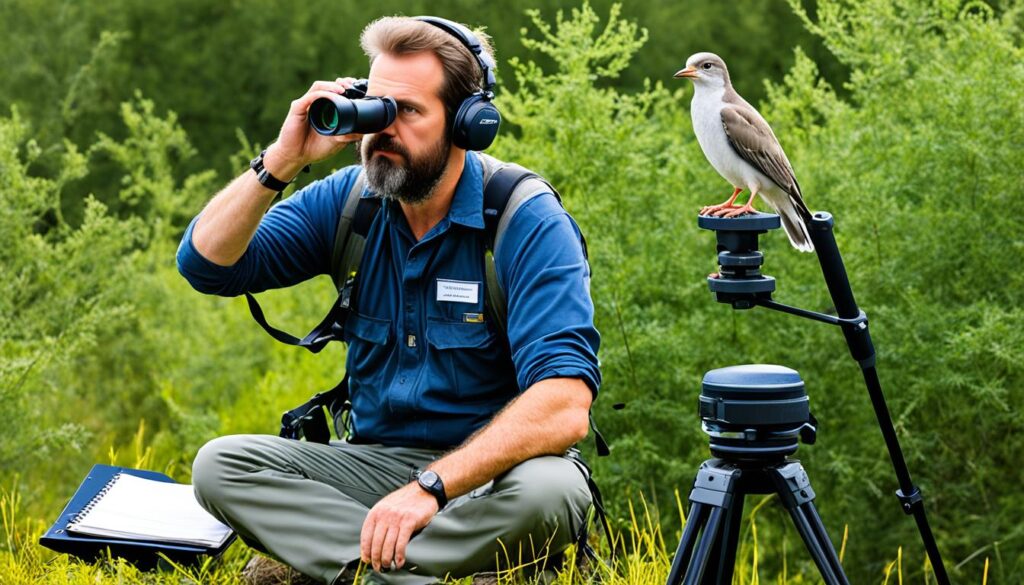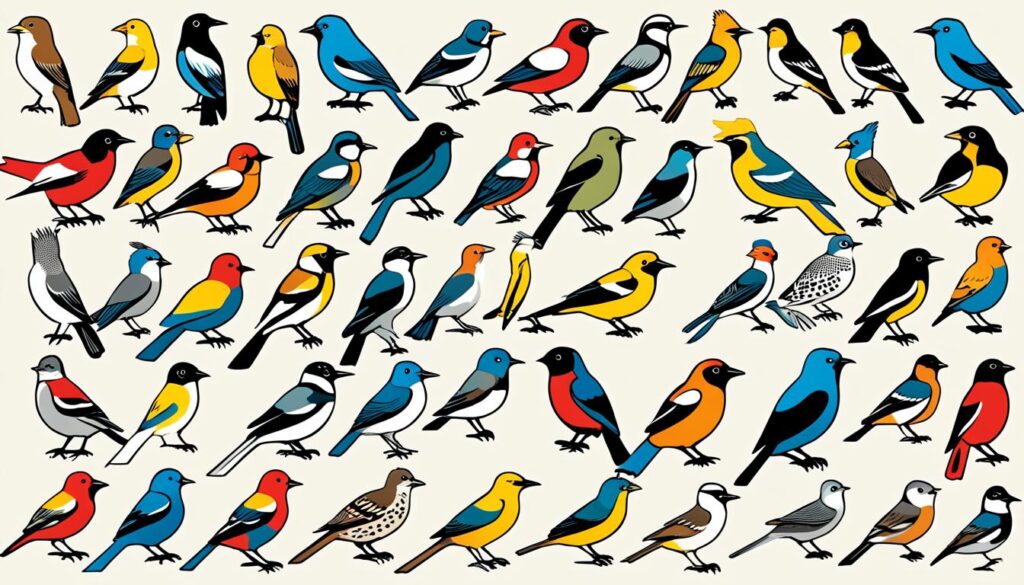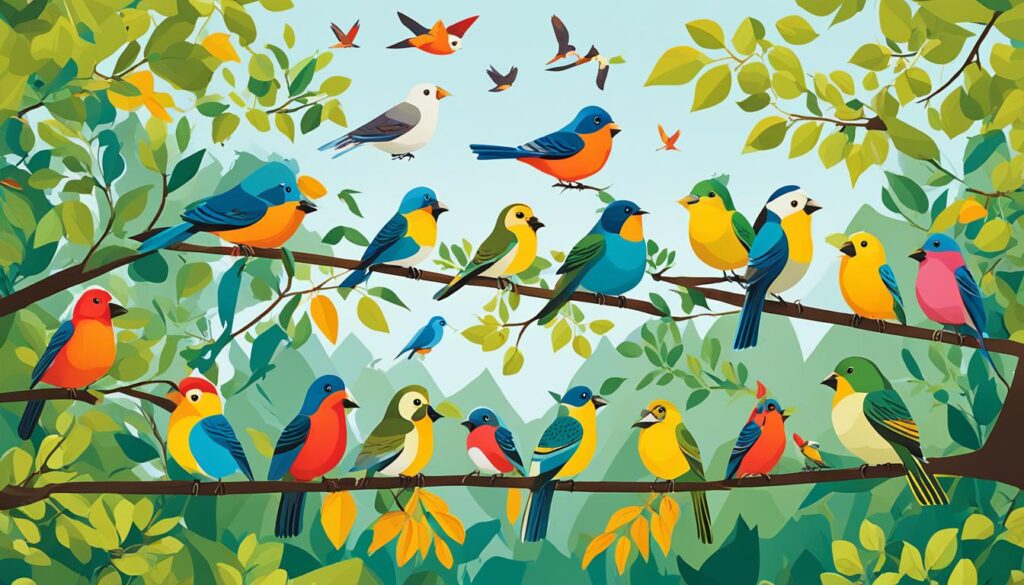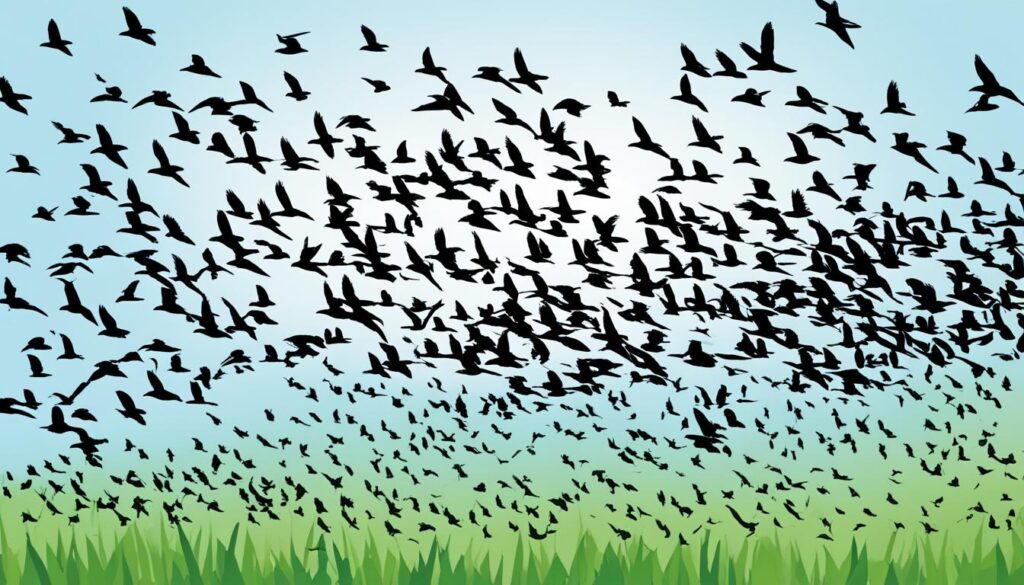Recently, scientists counted a high 7,920 bird species worldwide. This is way more than the previous count of about 10,500. The new number shows that we didn’t realize how diverse bird species are. This new count uses a wider way of deciding what makes a species. It looks at unique features and genetic details, not just the traditional view.
When looking at 200 bird types, researchers found nearly 2 unique groups within each type. This led them to estimate well over 18,000 such groups globally. Though this approach helps us see bird differences better, not everyone agrees with it. Some say this way of defining species might complicate efforts to save them. Figuring out the best way to count and protect bird types is still a big topic for scientists and talks.
Key Takeaways
- Recent studies have identified over 7,900 bird species worldwide, a significant increase from previous estimates.
- The new count is based on a broader definition of “species” that considers unique physical and genetic traits.
- Researchers estimate the total number of unique bird taxa could exceed 18,000 globally.
- The methodologies used in the study have drawn some criticism from experts regarding their practical application for conservation efforts.
- Accurately measuring and protecting avian biodiversity remains an ongoing challenge and area of active research.
Introduction to Bird Species Diversity
The world of birds is full of amazing species. From the small bee hummingbird to the big ostrich, birds come in many sizes and colors. Each one has its special traits for life. This variety is key for scientists, those wanting to protect nature, and people who love the outdoors.
Challenges in Defining and Counting Bird Species
Figuring out how many bird species there are is tricky. A common way has been to group birds that can mix their genes. But now, there’s a new way. It looks at the unique features of each bird, like its genes and looks. This means we find more diverse groups among what we thought were just one group.
The Importance of Understanding Avian Biodiversity
Knowing all about birds helps in saving them. By clearly knowing different bird species and where they live, we can make good plans to keep them safe. We also learn a lot about how life evolves and how birds help keep our world healthy.
| Statistic | Value |
|---|---|
| Extant Bird Species | 10,711 |
| Extinct Bird Species | 158 |
| Endangered Bird Species (IUCN Red List) | 1,223 |
| At-Risk Bird Species in the United States | 74 |
“Birds range in size from the two-inch bee hummingbird to the nine-foot ostrich, exhibiting a vast spectrum of physical characteristics across species.”
Methodologies for Surveying Wild Birds
Scientists use many methods to study wild birds. One main way is the point count survey. In this method, researchers count all the birds they see and hear within about 50 meters during a 10-minute watch. This way, they can make fair comparisons about the number and types of birds living in different places.
Point Count Method for Field Surveys
The point count method means watching for birds at each marked spot along a 500-meter path. Teams of two to four people work together. They note down the birds they see and hear, with one person in charge of writing it all down accurately. To get the best results, they mix up the order of the spots they watch each day. They also start early in the morning to catch more birds.
During the count, they carefully jot down details. This includes the spot’s code, time, bird type, and how the bird was spotted. They make sure not to count the same bird twice and note the surrounding area’s visibility. If they hear or see a bird outside their count time, they still record it to be thorough.
This method offers a reliable way to check bird numbers and types in different places. It helps us study and protect bird populations effectively.

“Defining explicit objectives is the initial step in designing a monitoring program. Objectives vary in complexity, with some requiring more resources and providing more valuable information than others.”
| Survey Method | Description | Key Considerations |
|---|---|---|
| Point Count | Observers record all birds seen and heard within a fixed radius (often 50 meters) from a specific vantage point over a set 10-minute duration. |
|
| Opportunistic Sightings | Record all bird sightings or hearings outside the formal observation period to encompass additional bird presence. |
|
Global Bird Species Count and Diversity
Recent research has found 7,920 bird species worldwide. This is more than our previous understanding. It shows a better grasp of what makes a unique bird species.
Number of Bird Species Identified Worldwide
Colombia tops the list with 1,917 bird species, making up 18.30% of the world’s bird diversity. Behind it is Peru with 1,892 species and Brazil with 1,864. This shows a rich variety of birds.
Indonesia and the United States, along with Uganda, hold 1,036 species each. Even small places like Bermuda and Luxembourg play a big role. They have 288 and 284 species, showing every place is important for bird life.
| Country | Number of Bird Species | Percentage of Global Total |
|---|---|---|
| Colombia | 1,917 | 18.30% |
| Peru | 1,892 | 18.06% |
| Brazil | 1,864 | 17.80% |
| Indonesia | 1,791 | 17.10% |
| United States | 1,036 | 9.89% |
| Uganda | 1,036 | 9.89% |
| Bermuda | 288 | 2.75% |
| Luxembourg | 284 | 2.71% |
The study had help from all over the world. 210 places took part. People shared 384,416 eBird checklists and 313,874 Merlin Bird IDs. They also uploaded 164,740 photos and sounds.
The US led this effort with 212,673 checklists and found 676 species. This shows how important everyone is in learning about birds.
Redefining Species: The Taxonomic Debate
The debate on defining bird species causes much friction in science. For years, the “biological species” idea was the go-to. It grouped birds who could have babies together successfully. This way has been used for more than a century.
Traditional Biological Species Concept
Ernst Mayr introduced the biological species concept in the 1940s. It mainly looks at whether birds can mix and create babies that can have their own. But, it’s starting to be questioned. It doesn’t always account for how complex bird evolution can be.
Phylogenetic Species Concept and Taxa
A newer idea, the phylogenetic species concept, is being considered. It looks at unique traits that set groups of birds apart. This means it counts more kinds of birds as separate species. It’s better at finding differences in genes and looks that might not show in who can have babies.
“The debate over how to define and delineate bird species has long been a source of contention in the scientific community.”
This new concept has changed how we see bird variety. It’s found many hidden species not seen before. This matters a lot for keeping different bird families safe.

The science world is still working on how to define bird types. This debate shows we need a better way to know about bird variety. Exploring new ways can help us understand the deep connections among bird species worldwide.
Estimating the World’s Bird Taxa
A study looked at the total number of bird types in the world. They used a broader way to define them. The team checked 200 bird types closely. They looked for key features in museum samples to show they are different groups.
The study found over 18,000 different bird types. This is almost double the known bird types. On average, they saw close to 2 new types for each bird type. The most they found in one bird type was 11.
Adding to this, the team used genetics on 200 bird types. They found 437 unique types. On average, each of these had 2.4 subtypes. This suggests we have about 20,000 distinct bird groups. This is a lot more than the 9,000 to 10,000 before.
Dr. Joel Cracraft is the main author. He said redefining ‘species’ helps do better in conservation. It might mean we can save more bird types. But, some scientists think this could cause problems. They worry it might not protect each bird as it should.
There’s a big talk about what ‘species’ really means. Some want to count it by looking at special groups in each type. This shows there might be a problem between saving birds and new ways we see them. We’re still learning a lot about bird types. This is very important for how we take care of them in the future.
“The redefinition of ‘species’ to include unique subgroups or taxa aims to offer better conservation tools, potentially allowing the protection of more diverse avian life forms.”
– Dr. Joel Cracraft, lead author of the study
Implications for Conservation Efforts
The discussion on defining and counting bird species affects conservation work. Traditionally, efforts focus on saving specific species. Yet, some suggest a broader approach is needed. They argue for protecting all distinct groups, even if they’re not seen as separate species.
Protecting Biodiversity Beyond Species Level
There’s a new view on what a species is, focusing on its unique history. Those in favor say we should save all unique bird groups, not just distinct species. This change could influence how we select and prioritize what to save.
It means we might pay more attention to certain bird types, like subspecies or unique populations, at higher risk. By looking at these groups, we could save more vulnerable bird species.
| Statistic | Value |
|---|---|
| Nearly 3 billion breeding birds lost in North America since 1970 | 3 billion |
| Birds killed annually from hitting windows in the U.S. and Canada | 1 billion |
| Birds killed annually by cats in the U.S. and Canada | 2.4 billion |
| Land converted to developed land in the U.S. from 1982 to 1997 | 10 million acres |
| Pesticides applied annually in the United States | 1 billion pounds |
| Plastic accumulated worldwide in landfills and the environment | 4,900 million metric tons |
This new way of thinking about conservation is crucial. It could lead to better protection for a wider range of bird types. This improvement could help birds worldwide thrive for the long term.

“The world’s most abundant bird, the Passenger Pigeon, has gone extinct. Habitat loss, degradation, and fragmentation are identified as the potentially largest threats to migratory birds.”
Saving bird varieties at the group level needs a more complex strategy. It includes working together worldwide, fixing and managing habitats, and using new methods to keep an eye on at-risk birds.
Regional Bird Diversity Insights
The 2024 Global Bird Survey highlighted the amazing variety of birds worldwide. It showed how active birdwatching is in the United States, leading the count with over 212,000 eBird checklists. This effort helped spot 676 bird species across the nation.
California, Texas, and Florida were tagged as top spots for bird watching. They offer a mix of habitats – like wetlands by the coast and vast grasslands. Many birds found there live only in those areas, showing why it’s key to protect their homes.
Looking further, the survey also told us about birds worldwide. Tropical places such as the Amazon and Southeast Asia have the most species. They keep many surprises still not fully known. On the other hand, cooler places with more people, like Europe, have fewer bird types but more detailed records.
| Region | Number of Bird Species | Endemic Species Percentage | Key Habitats |
|---|---|---|---|
| California | 547 | 12% | Coastal wetlands, oak savannas, coniferous forests |
| Texas | 615 | 8% | Riparian zones, grasslands, scrublands |
| Florida | 522 | 10% | Mangrove swamps, pine flatwoods, coastal dunes |
| Amazon Basin | 1,800+ | 30% | Tropical rainforests, flooded forests, savannas |
| Southeast Asia | 1,400+ | 25% | Tropical evergreen forests, montane forests, peatlands |
The survey reminds us to keep studying and protecting bird life. Thanks to tools like eBird and Merlin Bird ID, our knowledge keeps growing. This informs important plans to keep bird populations healthy.
“The diversity of bird species in a region is a testament to the richness and resilience of its ecosystems. Protecting these avian habitats is crucial for sustaining the delicate balance of life on our planet.”
Rare and Surprising Bird Sightings
The recent Global Bird Survey found many rare and fascinating birds. They showed us how dynamic bird patterns can be. These changes are often due to things like climate change.
In North America, something rare happened. White-crowned Sparrows and Lapland Longspurs appeared in Saskatchewan, Canada. This was unusual because these birds are not often seen there. In the Northwest Territories, Gray-crowned Rosy-Finches made an appearance. This area normally sees them in the southwest U.S. and western Alaska. These sightings made up 8% of all birds seen there.
Globally, the survey found over 150 species that had not been spotted in certain places before. Surprisingly, 32% of these finds were by people who are new to birdwatching. This shows how important it is for everyone to help track avian biodiversity.

“The wealth of rare and unexpected bird species we’re observing is a testament to the dynamic nature of our avian populations. These sightings underscore the importance of continued monitoring and conservation efforts to protect biodiversity beyond the species level.”
As the world’s climate changes, we might see more rare bird sightings. Birds will adjust to new climates. It’s important to keep watching them and protecting their home.
Popular Bird Species Identified
The 2024 Global Bird Survey covered many rare and threatened bird species. It also brought attention to well-known common bird species. These birds are often spotted in cities and in people’s backyards. They are key to keeping our local ecosystems healthy.
Notable birds found during the survey included the American Robin, House Sparrow, and Blue Jay. They are adaptable and can survive in various places in North America.
| Common Bird Species | Percentage of Total Bird Sightings | Typical Habitat |
|---|---|---|
| American Robin | 12% | Urban, Suburban, Parks |
| House Sparrow | 9% | Urban, Suburban, Farmland |
| Blue Jay | 7% | Deciduous Forests, Parks, Suburban |
| Mourning Dove | 6% | Urban, Suburban, Farmland |
| Canada Goose | 5% | Wetlands, Parks, Urban |
These well-spotted birds show how good they are at living in different places. They can do well in cities and in the quieter parts nearby. Being so adaptable, they are a big part of the bird life in both cities and near homes all over North America.
“The continued presence of these ubiquitous bird species is a testament to their ecological importance and the adaptability of avian life in the face of rapid urbanization and environmental change.”
Looking closer at the 2024 findings, knowing about these birds is very important. This knowledge helps us to protect them. It also ensures our cities and backyards continue to have birds for us to enjoy.
how many birds
Researchers from the Global Bird Survey found 7,920 unique bird species worldwide. This is a big increase from the earlier count of about 10,500 species. The change comes from a better understanding of what makes a bird “unique”.
This new count shows us the rich diversity of birds in our world. From the huge albatross to the tiny hummingbird, we have a wide range of birds around us. This variety is not only interesting for bird lovers and nature fans. It also shows how important birds are for keeping nature in balance.
| Metric | Value |
|---|---|
| Total Bird Species Identified Worldwide | 7,920 |
| Previous Estimate of Bird Species | ~10,500 |
| Percentage Increase in Identified Species | 24.5% |
More bird species means we need to study them more. Learning about birds helps us in many ways. We figure out how many there are and how they fit into nature. This helps us protect them and the places they live.

“The more we learn about birds, the more we realize how little we know. Each new discovery opens up a world of possibilities and inspires us to dive deeper into the rich tapestry of avian life.”
Knowing more about bird species helps us take better care of our planet. It lets us understand why bird variety is important and how to keep it safe. This way, future generations can enjoy the beauty and wonders of birds.
Avian Population Monitoring Initiatives
Many more people now help keep track of the world’s bird populations thanks to citizen science. Plus, tools like the eBird platform and Merlin Bird ID app make it easy. They allow folks to share what they know about birds, benefiting everyone’s understanding of them.
Citizen Science and Community Engagement
By getting the public involved, bird monitoring has expanded. Now, anyone who enjoys watching birds or being out in nature can help. This boosts the amount and quality of data, helping experts learn more about bird life around the world.
- eBird has collected data from over 800 million bird observations by 500,000 registered users globally.
- The Merlin Bird ID app, from the Cornell Lab of Ornithology, has been used over 10 million times to recognize various bird species.
- Big volunteer events like the Christmas Bird Count and Global Big Day have brought many together to study birds.
These initiatives have deepened our bird knowledge and brought people closer to nature. They’ve also spurred conservation efforts.
“The more people who participate in bird monitoring, the more we can learn about the health and distribution of bird populations around the world.”
As citizen science and community efforts grow, they’ll significantly help understand and protect birds worldwide.
Factors Influencing Bird Species Distribution
The number and type of birds we see depend on several complex things. The most important is the kind of places they can live in. For example, in Lishui City, Zhejiang Province, China, there are 370 bird species. But, 129 of these stay all year and 112 come only in winter.
However, the area is changing fast. Urban areas are growing, and forests and farmlands are shrinking. This makes it hard for the birds to find good places to live.
Habitat Suitability and Availability
What the land looks like is very important for bird life. Things like forests, shrubs, grasslands, and even bare land matter. There are special measurements to see how birds use these different places.
The number and kinds of birds in an area depend on these measurements. Good places for birds mean more birds of different types.
Also, things like how hot or cold it is, and if the environment is good for moving around can affect birds. This is especially true as we go up mountains or move to different parts of the world.
With our cities growing, we need to be careful. We should study how nature and birds fit together. This is key for saving the birds and their homes.
FAQ
How many bird species have been identified worldwide?
Scientists have pointed out 7,920 species of birds globally in a recent survey. This number is much lower than the previous 10,500 count. It’s because they now define “species” more broadly.
What are the challenges in defining and counting bird species?
Defining and counting bird species is tough and often debated. The old way was to group birds that can have babies together. But now, scientists see each bird’s unique genetic and physical traits too. This changes how many types of birds they find.
What are the common methods used for surveying wild bird populations?
Researchers use many ways to study wild birds. One way is the “point count” survey. Here, they jot down all the birds they see and hear within a set area. This helps them understand how many birds are in an area and what kinds are there.
How has the recent Global Bird Survey impacted our understanding of avian diversity worldwide?
The 2024 Global Bird Survey showed us a lot about bird variety in different places. In the United States, the survey found 676 different bird species. It was thanks to discoveries like these that we learned more about where certain birds live.
What are the implications of redefining bird species for conservation efforts?
How we count bird species affects how we protect them. Some think we should save groups with unique physical and genetic traits too. This might help save more bird life.
How has citizen science contributed to our understanding of avian biodiversity?
The 2024 Global Bird Survey had lots of help from regular people. Sites and apps like eBird and Merlin made it easier for all of us to share what we see. This teamwork increased our knowledge about birds.
What factors influence the distribution and diversity of bird species around the world?
Birds live in places that match what they need, like food and shelter. The world’s bird variety is shaped by these environmental needs.


Greate pieces. Keep writing such kind of information on your page.
Im really impressed by your blog.
Hi there, You’ve done a great job. I will certainly digg it and in my
opinion suggest to my friends. I am confident they’ll
be benefited from this website.
My blog: nordvpn coupons inspiresensation, http://t.co,
Please let me know if you’re looking for a article author
for your site. You have some really good articles and I believe I would be a good asset.
If you ever want to take some of the load off, I’d absolutely love to write some material for your blog in exchange for
a link back to mine. Please shoot me an e-mail if interested.
Cheers!
Stop by my website Nordvpn Coupons Inspiresensation –
Wall.Sh,
nordvpn promotion 350fairfax
Great delivery. Sound arguments. Keep up the great effort.